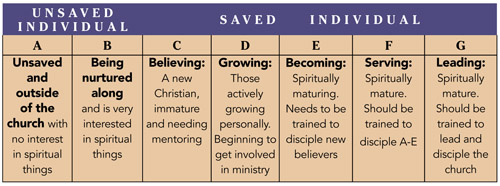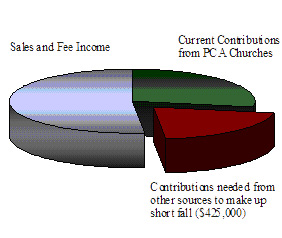Suggestion: Do this 2-3 hour activity with all of your church leaders. Give this scenario: You have 15 new Christians who know nothing about the Bible. You have 3 hours to meet and disciple them every week. You must determine what they should know, be, and be able to do after 3 years. By the end of this exercise you will understand if your church is truly discipling its people and why you need to set a direction for discipleship.
Secondly, we need to stop thinking that because we teach a class on discipleship that we have discipled our people! Discipleship is a life-long process moving a person from where he or she is to being like Jesus. Here is another suggestion.
Draw up a sheet for every individual in your church. Put the person’s name on the top. Then use this chart – or something that better fits your situation.

Then put something like:
 Your leaders meeting with every individual is a good way to determine where he or she is on this progress chart. By the way, this is a good way to go about your shepherding responsibilities. Then plan how you will disciple this person to move along until he or she is living with a Christian world and life view and is able to disciple someone else.
Your leaders meeting with every individual is a good way to determine where he or she is on this progress chart. By the way, this is a good way to go about your shepherding responsibilities. Then plan how you will disciple this person to move along until he or she is living with a Christian world and life view and is able to disciple someone else.
Are you beginning to see the difference between this approach to discipleship and what you are doing now? With this plan you will multiply your disciplemaking capacity. You will also develop a church filled with ministers. Remember: a pastor was never called to do the work of the ministry, but to “equip the saints for the work of ministry” (Eph. 4:11-12). The Great Commission calls us to make disciples!
Many pastors try to do everything, and they burn out, because they have not grasped that the role of the pastor is one of equipping (here is that CE word again). The only way we can equip the saints to do the work of the ministry is to disciple them! The only way we can disciple them is by having a plan (better know as a curriculum – another CE term). A curriculum is a roadmap that will enable you to move people from where they are to where they can effectively disciple others. What pastor would not want a church filled with people equipped to do what he would have to do by himself?
As I said at the beginning, Christian Education is not just Sunday school – it never was! CE demands that we have a curriculum in place. A curriculum helps us to see where we are headed so we can make plans how we will get there.
Remember the schoolteacher’s “plan”? What is your plan? Download our suggested lesson planning sheet.
If you need help doing this, Christian Education and Publications and Great Commission Publications are here to help. We offer seminars of all kinds to help your church be better disciplemakers. We have developed a brochure that you can use to develop your own Christian education plan, Does Your Church Have a Discipleship Plan?




